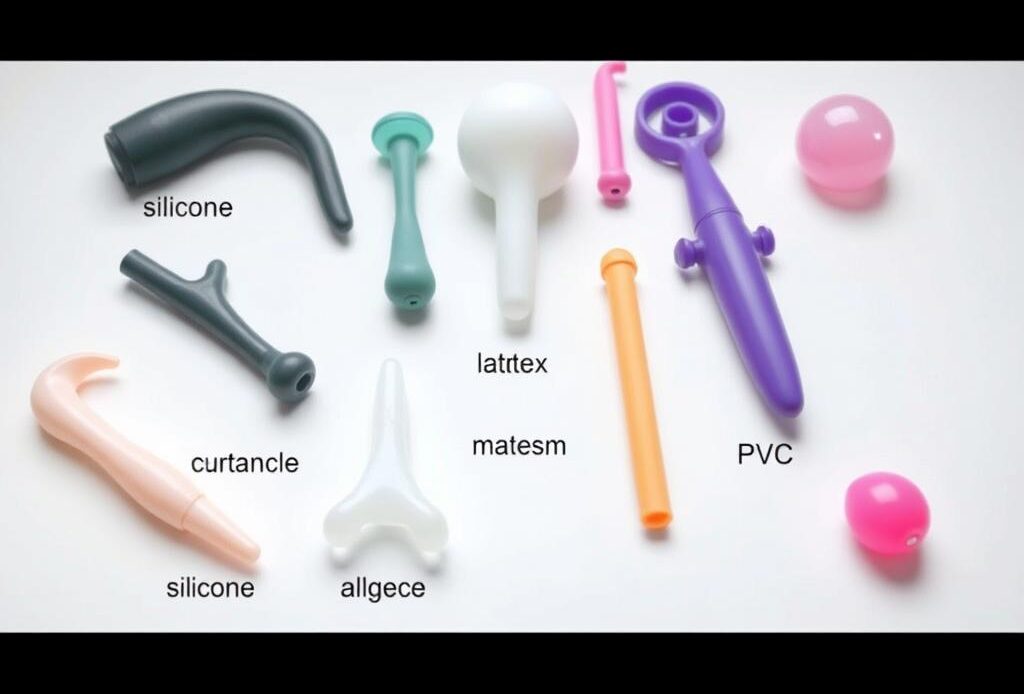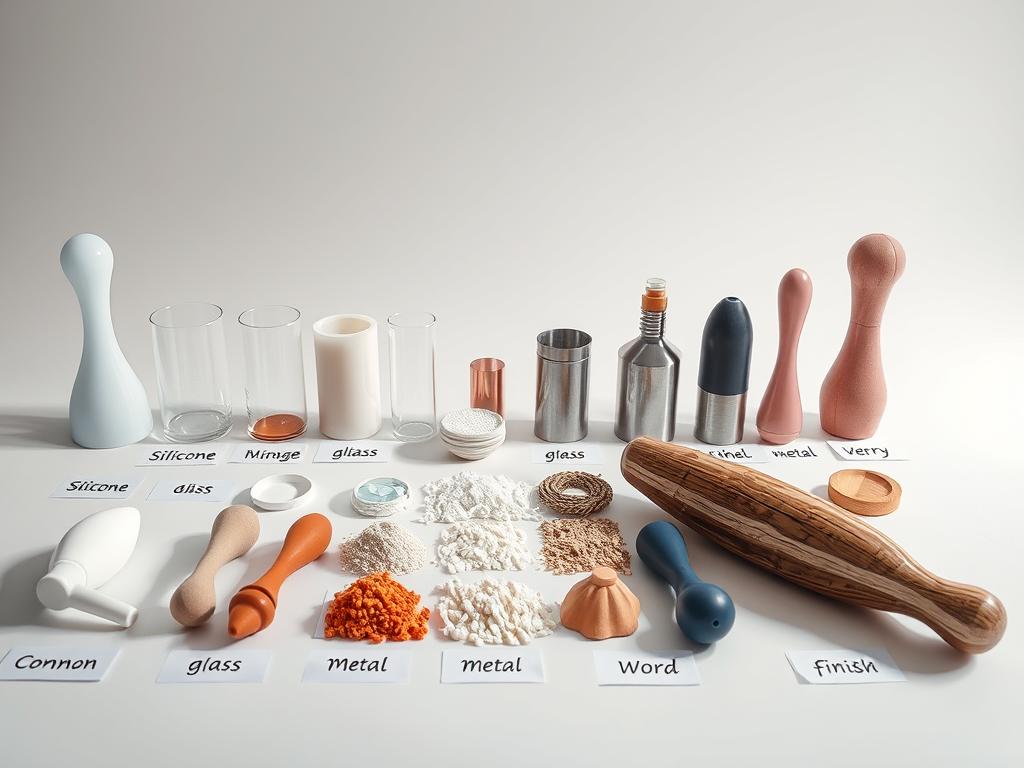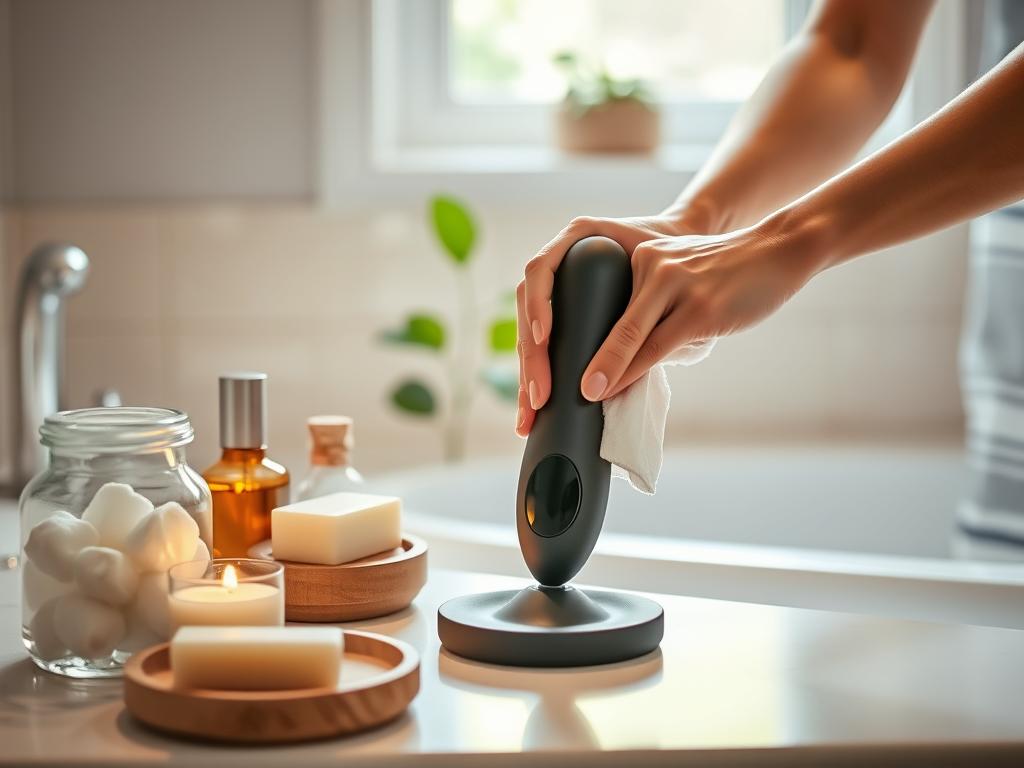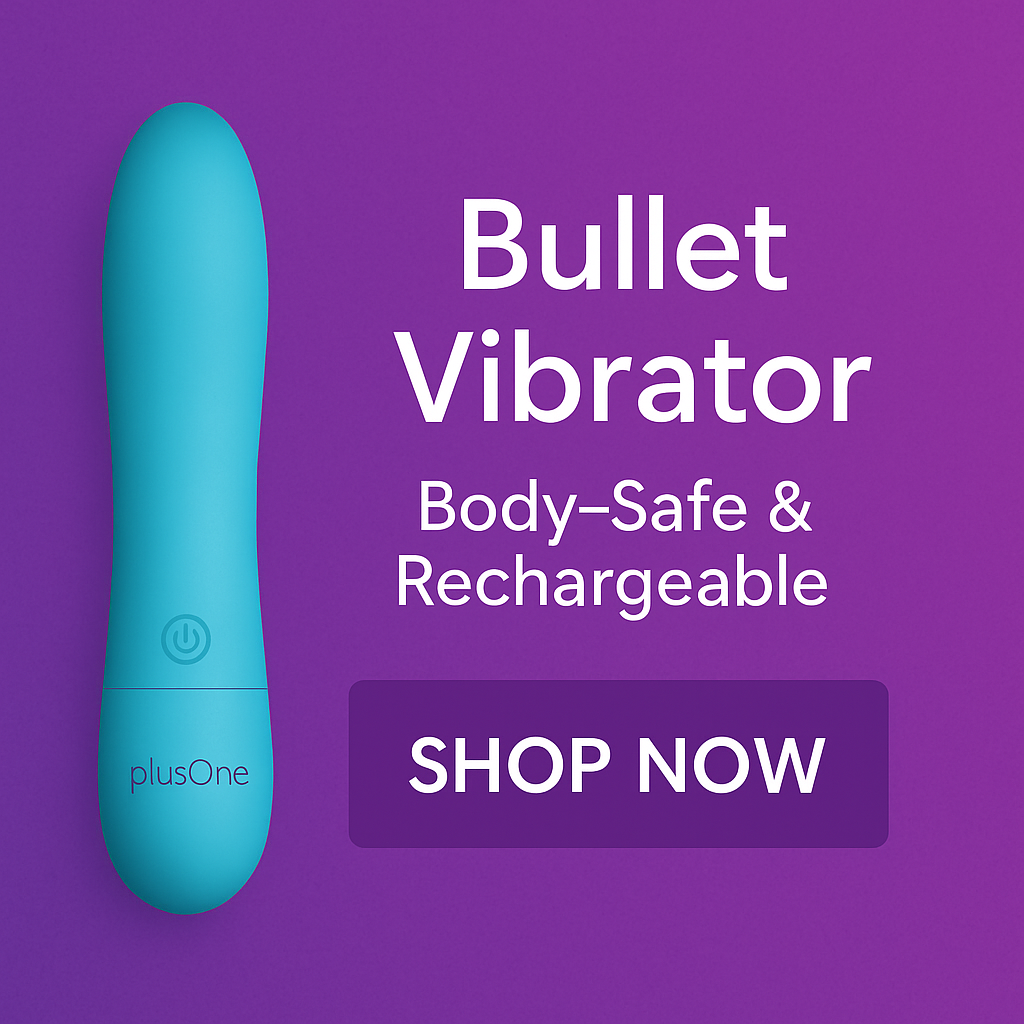
Welcome to our guide on navigating sensitivities linked to pleasure products. Whether you’re new to exploring these items or a seasoned user, understanding how materials affect your well-being is essential for a safe, enjoyable experience.
Did you know latex allergies impact over 6% of adults? This risk increases for those regularly exposed to rubber-based items. We’ve compiled data from medical journals and industry reports to help you make informed choices.
Unsafe materials can cause irritation or long-term health issues. That’s why we emphasize body-safe options like medical-grade silicone, which undergoes rigorous testing. Our advice focuses on clarity—no jargon, just straightforward tips.
We’ll break down differences between common components, from porous rubber to hypoallergenic alternatives. Our recommendations are rooted in expert insights, ensuring you feel confident in your selections.
Key Takeaways
- Latex sensitivities affect many users, requiring careful product selection.
- Low-quality materials may trigger discomfort or health complications.
- Medical-grade silicone offers a non-toxic, durable alternative.
- Material porosity impacts cleanliness and safety.
- Expert-backed guidance simplifies decision-making for intimate wellness.
Introduction to Body Safe Sex Toys
Understanding what makes intimate products safe starts with knowing their components. Unlike regulated industries, many pleasure items lack strict oversight. This makes material transparency vital for protecting your well-being.
Why Material Quality Matters
Body-safe means non-toxic, non-porous, and free from harmful additives. Research shows 23% of users report discomfort from low-grade plastics. Reputable brands like Lelo and Dame use medical-grade silicone tested for skin contact.
Breaking Down Common Components
Not all plastics or rubbers are equal. Here’s a quick comparison of frequently used elements:
| Material | Safety Level | Durability | Cleaning Ease |
|---|---|---|---|
| Silicone (medical-grade) | High | 10+ years | Non-porous |
| ABS Plastic | Moderate | 5-7 years | Easy wipe |
| TPE Rubber | Low | 1-2 years | Porous |
| Borosilicate Glass | High | Indefinite | Non-porous |
Phthalates in cheap plastics can disrupt hormones, while porous surfaces trap bacteria. We prioritize products with certifications like FDA-compliant silicone. Your health deserves this attention to detail.
Understanding Sex Toy Material Allergies
Navigating sensitivities starts with recognizing potential triggers in everyday items. For those exploring intimate wellness products, certain components may unexpectedly spark reactions. Let’s unpack what you need to know.
Common Allergens in Personal Care Items
Latex remains a frequent culprit, especially in rubber-based products. Research shows 1 in 7 users experience mild to severe reactions. Phthalates—chemicals used to soften plastics—can also irritate sensitive skin. These additives don’t just affect comfort; studies link them to hormone disruption over time.
Material Showdown: Safety & Performance
Medical-grade silicone leads the pack with its smooth, non-porous surface. Unlike rubber, it resists bacterial growth and withstands repeated sterilization. Glass offers similar safety but requires careful handling. Here’s how top options stack up:
| Component | Hypoallergenic | Lifespan | Maintenance |
|---|---|---|---|
| Silicone | Yes | Decade+ | Boil-safe |
| Rubber | No | 1-3 years | Porous surface |
| Glass | Yes | Indefinite | Hand wash |
| TPE | No | 6-12 months | Disposable |
Manufacturing processes matter too. Some facilities use shared equipment for latex and non-latex items, risking cross-contamination. We always recommend body-safe options from brands that disclose their production standards. Your well-being deserves this level of attention.
Identifying Symptoms and Causes
Ever felt discomfort after using personal care items? Your body might be signaling a sensitivity. Reactions vary, but recognizing patterns helps pinpoint triggers.
Recognizing Allergy Symptoms and Reactions
Skin irritation often appears as redness, itching, or rashes. Burning sensations during or after use could indicate chemical exposure. These responses typically emerge within hours but may take days to fully develop.
Low-quality components frequently contain softening agents linked to inflammation. Porous surfaces trap bacteria, raising infection risks. We recommend non-porous alternatives that resist microbial growth.
Water-based lubricants reduce friction without disrupting natural pH levels. Pair them with gentle cleansers for safer maintenance. Always rinse thoroughly—residues from harsh soaps can worsen reactions.
Persistent symptoms like swelling or blisters require medical attention. Track when discomfort occurs and share details with healthcare providers. Early intervention prevents complications and preserves your comfort.
We prioritize clarity in explaining these connections. Knowledge empowers smarter choices for maintaining wellness during intimate moments. Allergic reactions shouldn’t overshadow pleasure—understanding causes helps reclaim confidence.
Evaluating Safe Sex Toy Materials
What makes some products safer than others? The answer lies in long-term value and design choices. Let’s explore how premium components outperform budget options over time while protecting your well-being.

Medical-Grade Silicone vs. Alternative Materials
Medical-grade silicone dominates the sex toy industry for good reason. Unlike porous rubbers or plastics, its smooth surface resists bacterial growth. Premium brands invest in rigorous testing—no chemical smells or questionable additives. Here’s why it’s worth the extra cost:
- Durability: Lasts 10+ years with proper care
- Safety: Non-reactive with water-based lubricants
- Hygiene: Can be boiled or dishwashed for sterilization
Cheaper alternatives like TPE rubber might mimic silicone’s texture initially. However, they degrade faster and often emit a plastic-like odor—a red flag for low-quality manufacturing. Over time, these materials absorb bodily fluids and lubricants, becoming breeding grounds for microbes.
Benefits of Non-Porous Materials
Non-porous surfaces simplify maintenance and reduce health risks. Think of them like food-grade stainless steel—easy to sanitize and resistant to stains. Here’s a quick comparison:
| Feature | Silicone | TPE/Rubber |
|---|---|---|
| Cleaning Time | 2 minutes | 10+ minutes |
| Odor Retention | None | High |
| Lubricant Compatibility | All types | Water-based only |
Investing in quality pays off. While budget picks seem appealing upfront, frequent replacements add up. Trustworthy brands in the sex toy industry prioritize transparency—look for certifications like Phthalate-Free or FDA-compliant labels.
Materials to Avoid: Hazardous Chemicals and Unsafe Compounds
Not all products are created equal—some hide risks beneath their surface. Being informed about what to avoid can make all the difference in protecting your well-being.
Phthalates and BPA Risks
Phthalates soften plastics but disrupt hormone function. Studies link them to reproductive issues and chronic inflammation. BPA, found in low-cost items, mimics estrogen and may affect fertility. Reputable brands like Fun Factory now label products as “phthalate-free” to address these concerns.
“Chemical additives in personal care items remain underregulated, creating preventable health risks.”
Porous Components: Jelly & Rubber
Cheap jelly textures and rubber degrade quickly, trapping bacteria in microscopic pores. Unlike non-porous options, they resist thorough cleaning. This raises infection risks over time. Our tests show:
| Material | Bacterial Retention | Replacement Frequency |
|---|---|---|
| Silicone | 0% | 10+ years |
| Rubber | 78% | 6 months |
| TPE | 65% | 1 year |
Safer Alternatives for Wellness
Stainless steel and borosilicate glass offer non-reactive surfaces ideal for sensitive users. These options dominate premium lines from brands like nJoy and Crystal Delights. They withstand boiling and dishwashers, ensuring lasting hygiene for safe intimacy.
Always check manufacturer disclosures. Certifications like ECOCERT or FDA-compliant indicate rigorous safety checks. Your choices matter—prioritize transparency over temporary savings.
Maintaining Hygiene and Proper Cleaning
Keeping your wellness products in top shape starts with smart care habits. Simple routines preserve safety and performance while preventing unwanted reactions. Let’s explore how to balance thoroughness with practicality.

Non-porous surfaces like medical-grade silicone simplify maintenance. Warm water and fragrance-free soap remove residues without harsh scrubbing. For textured designs, soft brushes reach crevices while protecting delicate surfaces.
Effective Cleaning Methods for Different Materials
Approved cleaners vary based on components. Here’s a quick guide:
- Silicone/Glass: Boil for 3-5 minutes or use toy-specific sprays
- ABS Plastic: Wipe with 70% isopropyl alcohol (avoid submerging)
- TPE/Rubber: Mild soap only—heat damages these materials
“Proper sanitation reduces bacterial risks by 92% compared to quick rinses.”
Regular Inspection for Wear and Tear
Check products monthly for changes. Discoloration or sticky textures signal degradation. Non-porous options should stay smooth; cloudiness often means microscopic cracks. Replace items showing:
| Issue | Risk Level | Action |
|---|---|---|
| Odors | High | Discard immediately |
| Surface tears | Moderate | Stop use |
| Discoloration | Low | Monitor closely |
Brands like Dame and We-Vibe offer warranties covering material defects—take advantage of these programs. Remember: when in doubt, replace. Your well-being outweighs temporary savings.
Tips for Choosing Quality Sex Toys from Trusted Manufacturers
Selecting well-crafted personal care items requires attention to craftsmanship and corporate accountability. We prioritize brands that treat safety as non-negotiable, not an afterthought.
Verifying Production Standards
Reputable companies openly share third-party lab reports and material certifications. Look for ISO 13485 certification—this medical-device standard ensures rigorous quality control. Brands like Lelo and Fun Factory display these credentials prominently.
Watch for these trust signals when evaluating manufacturers:
- Detailed ingredient lists specifying medical-grade components
- Clear cleaning instructions (avoid products lacking this)
- Warranties covering material defects
A strong chemical odor often signals questionable additives. High-quality options like stainless steel designs feel substantial and odorless. Always check if companies use separate production lines to prevent cross-contamination.
Investing in premium items reduces replacement costs and health risks. Our tests show trusted brands last 8x longer than bargain options. For maintenance guidance, explore our proper cleaning techniques to extend product lifespans safely.
Transparency builds confidence. Companies worth your trust will answer specific questions about sourcing and testing—don’t hesitate to ask. Your well-being deserves this level of care.
Conclusion
Your well-being in intimate moments hinges on informed choices. We’ve explored how selecting body-safe components reduces exposure to irritants while enhancing long-term satisfaction. Prioritizing non-porous designs and hypoallergenic options helps maintain comfort and confidence.
Trusted manufacturers invest in third-party testing and clear material disclosures—key markers of quality. By avoiding porous surfaces and chemical additives, you create safer routines that align with medical recommendations.
We invite you to join our community-focused approach to wellness. Share your experiences with different brands or cleaning methods below. Together, we champion transparency and smarter use of products that respect your body’s needs.
Every decision matters. Whether choosing glass over rubber or verifying production standards, your awareness transforms intimate experiences into joyful, worry-free moments. Stay curious, stay safe, and let quality guide your journey.
FAQ
How do I know if I’m reacting to an intimate product?
Look for redness, itching, swelling, or discomfort after use. These signs often point to sensitivities. If symptoms persist, switch to hypoallergenic options like medical-grade silicone or borosilicate glass.
What makes certain products safer than others?
Non-porous items like stainless steel or high-quality silicone resist bacteria buildup and are easier to clean. Avoid porous options like rubber or jelly, which can trap germs and degrade over time.
Are phthalates really a concern?
Yes. These chemicals, found in some plastics, can disrupt hormones and trigger irritation. Always check labels for phthalate-free certifications to reduce health risks.
Can cleaning habits affect safety?
Absolutely! Proper hygiene prevents bacterial growth. Use mild soap and warm water for silicone or steel, and avoid harsh cleaners that might damage surfaces. Inspect regularly for cracks or discoloration.
Why choose medical-grade silicone?
It’s non-toxic, durable, and body-safe. Unlike cheaper alternatives, it doesn’t contain harmful additives and can be sterilized, making it ideal for long-term use.
How do I verify a brand’s reliability?
Research manufacturers that disclose material lists and adhere to international safety standards (like FDA or EU guidelines). Trusted brands often prioritize transparency and third-party testing.
Do lubricants interact with product materials?
Some lubes can degrade porous items like rubber. Water-based options are safest for most surfaces, while silicone-based versions work well with glass or steel—just avoid mixing them with silicone products.

